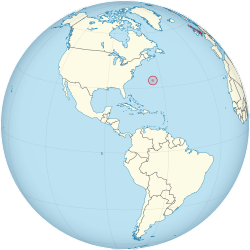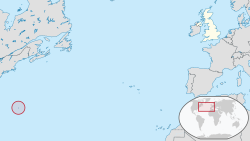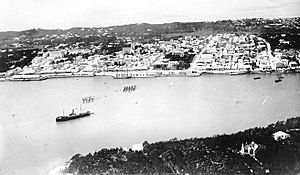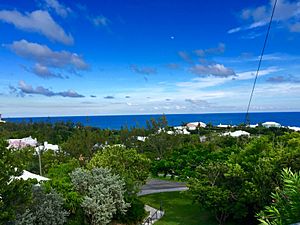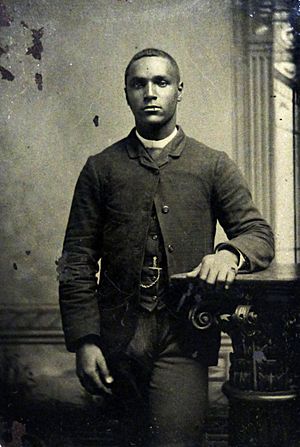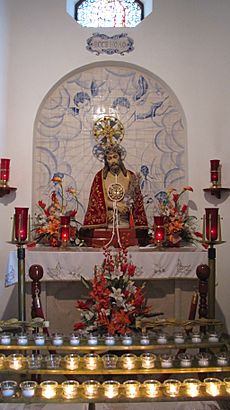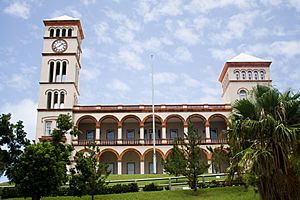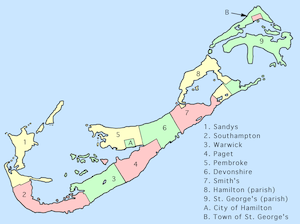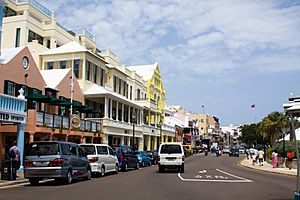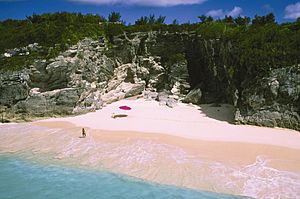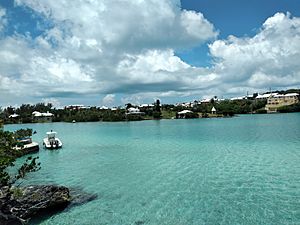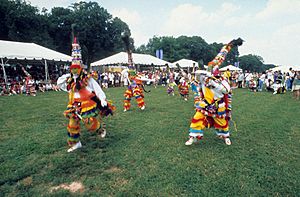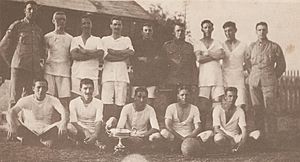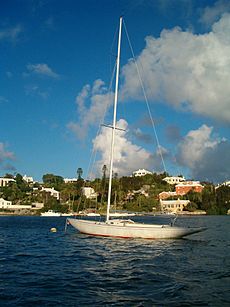Bermuda facts for kids
Quick facts for kids
Bermuda
|
|||
|---|---|---|---|
|
|||
| Motto(s): | |||
| Anthem: "God Save the King" | |||
| National song: "Hail to Bermuda" | |||
| Sovereign state | |||
| English settlement | 1609 (officially becoming part of the Colony of Virginia in 1612) | ||
| Capital and largest city
|
Hamilton 32°17′46″N 64°46′58″W / 32.29611°N 64.78278°W |
||
| Official languages | English | ||
| Ethnic groups
(2016)
|
|
||
| Demonym(s) |
|
||
| Government | Parliamentary dependency under a constitutional monarchy | ||
|
• Monarch
|
Charles III | ||
|
• Governor
|
Rena Lalgie | ||
|
• Premier
|
Edward David Burt | ||
| Legislature | Parliament | ||
| Senate | |||
| House of Assembly | |||
| Area | |||
|
• Total
|
53.2 km2 (20.5 sq mi) | ||
|
• Water (%)
|
27 | ||
| Highest elevation | 79 m (259 ft) | ||
| Population | |||
|
• 2019 estimate
|
63,913 (205th) | ||
|
• 2016 census
|
63,779 | ||
|
• Density
|
1,338/km2 (3,465.4/sq mi) (10th) | ||
| GDP (nominal) | 2019 estimate | ||
|
• Total
|
US$7.484 billion (161st) | ||
|
• Per capita
|
US$117,097 (4th) | ||
| HDI (2013) | very high |
||
| Currency | Bermudian dollar (BMD) | ||
| Time zone | UTC−04:00 (AST) | ||
|
• Summer (DST)
|
UTC−03:00 (ADT) | ||
| Date format | dd/mm/yyyy | ||
| Driving side | left | ||
| Calling code | +1-441 | ||
| ISO 3166 code |
|
||
| Internet TLD | .bm | ||
| Website | https://www.gov.bm/ | ||
Bermuda is a British Overseas Territory located in the North Atlantic Ocean. It's about 1,035 kilometers (643 miles) west-northwest of North Carolina, USA.
Bermuda is actually a group of 181 islands. Most of the main islands are connected by bridges, making them look like one big landmass. The total land area is about 54 square kilometers (21 square miles). Bermuda has a warm, tropical climate with mild winters and hot summers. The ocean keeps the temperatures steady and the air moist. Bermuda can experience strong storms called tropical cyclones, but a coral reef helps protect the islands.
The islands are named after Spanish explorer Juan de Bermúdez, who found them in 1505. People have lived there since 1612, when the English started a settlement in St. George's. Bermuda was once part of the Colony of Virginia. It became a crown colony in 1684, meaning it was directly ruled by the British Crown.
For a long time, Bermuda's economy was focused on the sea. It was a base for merchants, privateers (like legal pirates), and the Royal Navy. It even gave its name to a type of boat called the Bermuda sloop. Later, it became an important British naval and military base. Since the 1800s, tourism has been a big part of Bermuda's economy. After World War II, it also became a major place for international finance.
Bermuda is divided into nine areas called parishes. It is a self-governing parliamentary democracy with its own parliament in the capital city, Hamilton. The House of Assembly started in 1620, making it one of the oldest parliaments in the world. The Premier is the head of the government. The United Kingdom handles Bermuda's foreign affairs and defense. In 1995, people in Bermuda voted against becoming fully independent.
As of 2019, Bermuda has about 64,000 people. Around 50% of the population are Black Bermudians, and 30% are White Bermudians. There are also smaller groups from other backgrounds. Bermuda has its own dialect of English and strong connections with other English-speaking countries like the United States and Canada. It is also part of the Caribbean Community.
Contents
Bermuda's Name: Where Did It Come From?
Bermuda gets its name from the Spanish sailor Juan de Bermúdez. He found the islands in 1505 while sailing for Spain.
Bermuda's Story: A Journey Through Time
How Bermuda Was Discovered

Spanish explorer Juan de Bermúdez discovered Bermuda in the early 1500s. When he found them, no people lived on the islands. Spanish and Portuguese ships sometimes stopped there for fresh meat and water.
People started to tell stories about spirits and devils on the islands. These stories probably came from the sounds of noisy birds, like the Bermuda petrel, and wild pigs. Because of frequent storms and dangerous reefs, the islands were called the "Isle of Devils." Neither Spain nor Portugal tried to settle there.
English Settlers Arrive
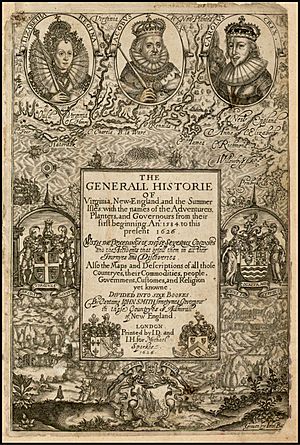
For about 100 years, ships visited Bermuda, but no one settled there. Then, in 1609, an English ship called the Sea Venture was heading to the Jamestown, Virginia colony. A big storm hit, and the ship crashed onto Bermuda's reefs. Everyone on board survived!
Some of these survivors decided to stay in Bermuda. They built two new ships and eventually sailed to Jamestown. In 1612, the English officially began settling Bermuda. They named the first capital New London, which was later renamed St. George's Town. It is the oldest English town in the New World where people have continuously lived.
Because Bermuda is small, early laws were made to protect its limited resources. For example, in 1616, laws were passed to stop people from hunting certain birds and young tortoises too much.
Early History of Enslaved People
In the early 1600s, enslaved people were brought to Bermuda. These were mostly people from Africa and Native Americans from the Thirteen Colonies. The first enslaved Africans arrived in 1617, coming from the West Indies.
As the number of enslaved people grew, some white settlers worried about rebellions. Laws were passed to control enslaved people. There were several rebellions over the years. In 1761, a big plan for a rebellion was found. Six enslaved people were executed, and all celebrations for black people were stopped.
English Civil War's Impact
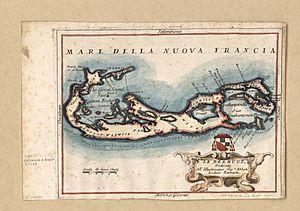
In 1649, the English Civil War was happening in England. King Charles I was executed. This conflict also affected Bermuda. Most colonists in Bermuda supported the King. They removed the company's governor and chose their own leader.
Bermuda's civil war ended peacefully. Some people who disagreed with the King's supporters moved to The Bahamas. In 1655, some Bermudians also moved to Jamaica.
Bermuda's Focus Shifts to the Sea
In the 1600s, the company that owned Bermuda wanted people to farm tobacco. But tobacco from Virginia was better. So, Bermudians started to focus on sea trades. They built ships and became involved in the salt trade from the Turks Islands. This became a very important part of Bermuda's economy. Bermudians also became good at whaling and privateering.
Many Bermudians today have ancestors who were Native Americans. Hundreds of Native Americans were brought to Bermuda as enslaved people, especially after wars in the New England colonies.
The American War of Independence
When the American colonies rebelled against Britain, Bermuda faced a problem. The Americans planned to stop trading with Britain and its colonies. This would have caused big problems for Bermuda, which relied on trade.
In 1775, Bermudians secretly helped the Americans by letting them take gunpowder from a storage building. Because of this, the Americans allowed Bermuda to continue trading with them. However, Britain then sent ships to watch over Bermuda and removed cannons from its forts. Despite this, some Bermudians continued to trade secretly.
After the American Revolution, the Royal Navy made Bermuda its main base in the Western Atlantic. In 1811, they started building a large dockyard on Ireland Island. To protect this base, the British Army built many forts around Bermuda.
During the War of 1812 between Britain and the United States, British attacks on Washington, D.C. were planned from Bermuda. Today, the National Museum of Bermuda is located in the old dockyard.
During the American Civil War, Bermuda was a key stopping point for ships called blockade runners. These ships helped the Southern states get supplies from England and send cotton back. The old Globe Hotel in St. George's was a meeting place for agents from the Southern states and is now a museum.
Boer War Prisoners
During the Anglo-Boer War (1899–1902), about 5,000 Boer prisoners of war were held on five islands in Bermuda. They were separated based on their views about the war. One famous prisoner, Captain Fritz Joubert Duquesne, escaped from Darrell's Island in 1902. He swam 1.5 miles to the main island and later became a spy.
The 1900s and Today
In the early 1900s, Bermuda became a popular place for tourists from America, Canada, and Britain. A railway line was built in the 1920s but was later closed.
In 1930, the first airplane landed in Bermuda. By 1937, regular flights started, bringing even more tourists. During World War II, the Hamilton Princess Hotel became a place where all mail and messages were checked by censors.
After the war, more regular flights started, and tourism grew a lot. However, by the late 1970s, international business became the biggest part of Bermuda's economy.
The British naval base and military presence were important to Bermuda's economy until the mid-1900s. US military bases were also in Bermuda from World War II until 1995.
In the 1960s, Bermuda changed its voting rules so that all adults could vote. In 1973, the governor of Bermuda, Richard Sharples, was assassinated. There were some discussions about Bermuda becoming fully independent, but in a 1995 vote, most people said no to independence.
At the 2020 Summer Olympics, Flora Duffy won Bermuda's first-ever Olympic gold medal in the women's triathlon. This made Bermuda the smallest territory to win a gold medal.
Bermuda's Geography: Islands, Caves, and Pink Sand
Bermuda is a group of islands formed by old volcanoes in the Atlantic Ocean. It's located east-southeast of North Carolina, USA. Bermuda is made up of 181 islands. The largest is called Main Island. Eight of the bigger islands are connected by bridges. The highest point is Town Hill, which is 79 meters (259 feet) tall.
Bermuda is famous for the Bermuda Triangle, a mysterious area of the sea where some planes and boats are said to have disappeared.
Popular Sights and Activities
Bermuda's pink sand beaches and clear blue waters are very popular with tourists. Many hotels are along the south shore. Besides beaches, there are many other things to see. Historic St. George's is a World Heritage Site.
If you like scuba diving, you can explore many wrecks and coral reefs in shallow water. You can also go snorkelling from the shore, especially at Church Bay.
The most popular place to visit is the Royal Naval Dockyard, which includes the National Museum of Bermuda. Other fun places are the Bermuda Aquarium, Museum and Zoo, the Bermuda Underwater Exploration Institute, and the Crystal Caves with their amazing stalactites and underground pools. Somerset Bridge is the world's smallest drawbridge!
Visitors are not allowed to drive cars on the island. You can use public buses, taxis, or rent scooters.
Bermuda's Climate
Bermuda has a warm, humid climate. The nearby Gulf Stream keeps the islands warm. It never snows or freezes in Bermuda. The coldest the temperature usually gets is around 10°C (50°F).
Summers can feel very warm due to humidity, but temperatures rarely go above 30°C (86°F). The ocean around Bermuda is warm, averaging about 22.8°C (73°F).
Bermuda is in a path where hurricanes often travel, but they usually weaken as they get close. Direct hits are rare because the island is small. Recent strong hurricanes that hit Bermuda directly include Hurricane Gonzalo in 2014 and Hurricane Nicole in 2016.
Bermuda has no rivers or lakes, so people collect rainwater from their roofs for fresh water. Every house usually has a tank to store this water.
Plants and Animals
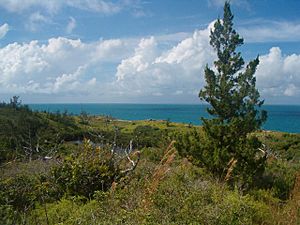
When Bermuda was discovered, it was covered in forests of Bermuda cedar trees. Today, about 20% of the island is still forest.
Many types of trees and plants have been brought to the island by settlers, like palm trees and fruit trees. Only 15 of the island's plant species are found nowhere else in the world.
Bermuda's only native mammals are five types of bat. The national bird is the Bermuda petrel, also called the cahow. This bird was thought to be extinct for a long time but was rediscovered in 1951! There are programs to protect it. Another well-known bird is the white-tailed tropicbird, or longtail, which comes to Bermuda to breed.
The Bermuda rock lizard was thought to be the only native land animal besides birds. But recently, scientists found that a type of turtle, the diamondback terrapin, was also native to Bermuda before humans arrived.
People of Bermuda
| Racial groups in Bermuda (2016 Census) | ||||
|---|---|---|---|---|
| Ethnic groups | percent | |||
| Black | 52% | |||
| White | 31% | |||
| Mixed | 9% | |||
| Asian | 4% | |||
| Other | 4% | |||
In 2016, Bermuda's population was 63,779 people. This means it has a lot of people living in a small area.
The population is made up of different groups: 52% are Black, 31% are White, 9% are multiracial, and 4% are Asian. About 70% of the people were born in Bermuda.
Many people have moved to Bermuda over the years, especially after World War II. A large part of the population (25%) has Portuguese ancestors, who came from islands like the Azores. There are also many workers from the United Kingdom, Canada, and the West Indies. They often work in finance or other specialized jobs.
Languages Spoken
The main language in Bermuda is Bermudian English. British English spellings are used in writing. Some people also speak Portuguese, especially those whose families came from the Azores or Madeira.
Religions in Bermuda
Christianity is the largest religion in Bermuda. Many different Protestant churches are present, like Anglican, Methodist, and Seventh-day Adventist. Roman Catholics also make up a significant part of the population.
The Anglican Church of Bermuda has the oldest non-Catholic church in the New World, St. Peter's Church.
How Bermuda is Governed
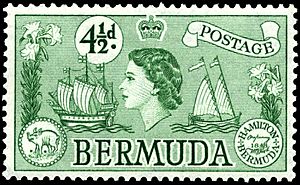
Bermuda is a British Overseas Territory, which means the Government of the United Kingdom is in charge of its overall defense and foreign affairs. The British monarch (currently Charles III) is the head of state, and a Governor is appointed by the King to represent him. The current Governor is Rena Lalgie.
Bermuda has its own government for local matters. It has a parliament that started in 1620, making it one of the oldest in the world. The parliament has two parts: the Senate and the House of Assembly. The Premier is the head of the government and is chosen by the political party that wins the most seats in the House of Assembly. The current Premier is Edward David Burt.
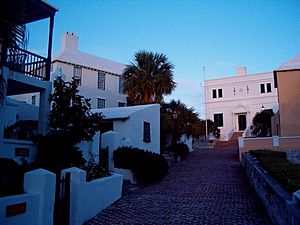
Elections for parliament happen every five years or less. The most recent election was in 2020.
The United States has the largest diplomatic office in Bermuda, with a Consulate and customs services at the airport. The US is Bermuda's biggest trading partner.
Bermuda's Divisions
Bermuda is divided into nine parishes and two main towns:
- Devonshire
- Hamilton
- Paget
- Pembroke
- Sandys
- Smith's
- Southampton
- St George's
- Warwick
The two main towns are:
- Hamilton (the capital city)
- St George's (a historic town)
There are also two smaller villages:
- Flatts Village
- Somerset Village
Police and Defense
Law enforcement in Bermuda is mainly handled by the Bermuda Police Service. The Customs Department and Immigration Department also help. Sometimes, the Royal Bermuda Regiment assists them.
Bermuda's defense is the responsibility of the British Government. For a long time, Bermuda was an important military base for Britain, known as "Fortress Bermuda."
During both World War I and World War II, Bermuda was very important for the Allies. It was a meeting point for ships crossing the Atlantic and a base for naval planes. In 1940, the US was allowed to build military bases in Bermuda, which they used until 1995. Canada also had a radio-listening post there.
After World War II, the British naval base and military presence were closed. Today, the only military unit in Bermuda is the Royal Bermuda Regiment. Until 2018, young men were required to serve in the Regiment, but now it is all volunteers. In 2020, the Royal Bermuda Regiment started the Bermuda Coast Guard to help with search and rescue, border control, and protecting Bermuda's waters.
Bermuda's Economy
Bermuda's economy is mostly based on banking and other financial services, which make up about 85% of its economy. Tourism is the second largest industry, at 5%. There is very little farming or manufacturing. Bermuda relies heavily on imported goods.
People in Bermuda have a high standard of living. In 2019, Bermuda had one of the highest GDP per person in the world.
Currency
In 1970, Bermuda changed its money from the Bermudian pound to the Bermudian dollar. The Bermudian dollar is equal in value to the US dollar. You can use US money in Bermuda, but banks might charge a fee if you exchange Bermudian dollars for US dollars to use outside the islands.
Finance and Business
Bermuda is known as an offshore financial centre. This means it has low taxes on personal or company income. Instead, it has high taxes on goods that are imported. This helps fund the government and public services.
Many large international insurance companies have offices in Bermuda. Over 15,000 international companies are registered in Bermuda, though most don't have physical offices or many employees there.
The Bermuda Stock Exchange (BSX) is a stock market that deals with different types of investments. It is a member of the World Federation of Exchanges.
Tourism
Tourism is Bermuda's second-biggest industry. Over half a million people visit Bermuda each year, and most of them are from the United States. Visitors also come from Canada and the United Kingdom.
Education in Bermuda
Bermuda has different types of schools:
- Aided schools get some money from the government.
- Maintained schools are fully owned and funded by the government.
- Private schools do not get public money.
Before 1965, schools in Bermuda were separated by race. When schools were desegregated, some schools chose to become private.
There are 38 schools in the public system, including preschools, primary schools, middle schools, and two senior schools. Since 2010, Portuguese has been taught as an optional language in schools.
For higher education, the Bermuda College offers various programs. Bermuda does not have universities that offer Bachelor's degrees. Most Bermudian students go to universities in the United States, Canada, or the United Kingdom for their higher education.
Bermuda's Culture
Bermuda's culture is a mix of its different populations, including Native American, Spanish-Caribbean, English, Irish, and Scottish influences. English is the main language. Because of many years of immigration from Portuguese islands, some people also speak Portuguese. There are strong British and Afro-Caribbean influences.
One important book by a Bermudian is The History of Mary Prince, written by Mary Prince in 1831. It tells the story of an enslaved person.
Arts and Music
When more tourists started coming after World War II, West Indian musicians brought calypso music to Bermuda. The Talbot Brothers were famous for playing calypso music for many years. Later, reggae music also became popular with Bermudians.
The Gombey dancers are a well-known part of Bermudian culture. Their dances are influenced by African, Caribbean, and British traditions.
Alfred Birdsey was a famous watercolor artist known for his paintings of Bermuda's landscapes and boats. Hand-carved cedar sculptures are also a special art form.
The Masterworks Museum of Bermuda Art displays art about Bermuda by artists from around the world. Bermuda also hosts an annual international film festival.
Sports in Bermuda
Many popular sports were brought to Bermuda by British military officers. These include cricket, football, rugby football, tennis, and rowing.
The Bermuda national cricket team played in the Cricket World Cup 2007. The Bermuda national football team qualified for the 2019 CONCACAF Gold Cup, their first major football competition. Bermuda also hosted the PGA Grand Slam of Golf several times. Famous Bermudian footballers include Clyde Best and Shaun Goater.
Sailing, fishing, and horse riding are also popular. The Newport–Bermuda Yacht Race is a famous sailing race. A unique sport in Bermuda is racing the Bermuda Fitted Dinghy.
At the 2004 Summer Olympics, Katura Horton-Perinchief made history as the first black female diver to compete in the Olympics. Bermuda has won two Olympic medals: a bronze in boxing by Clarence Hill and a gold in triathlon by Flora Duffy. It's a tradition for Bermuda's athletes to march in the Olympic Opening Ceremony wearing Bermuda shorts.
Images for kids
-
Residential suburb near the old St. George's Garrison, with "Town Cut Battery" or "Gate's Fort" on the shore of the Town Cut, and St. George's Town and its harbour in the background.
| Climate data for Bermuda (L.F. Wade International Airport) (1991-2020 normals, extremes 1949-2023) | |||||||||||||
|---|---|---|---|---|---|---|---|---|---|---|---|---|---|
| Month | Jan | Feb | Mar | Apr | May | Jun | Jul | Aug | Sep | Oct | Nov | Dec | Year |
| Record high °C (°F) | 25.4 (77.7) |
26.1 (79.0) |
26.1 (79.0) |
27.2 (81.0) |
30.0 (86.0) |
32.2 (90.0) |
33.1 (91.6) |
33.9 (93.0) |
33.2 (91.8) |
31.7 (89.0) |
28.9 (84.0) |
26.7 (80.0) |
33.9 (93.0) |
| Mean maximum °C (°F) | 23.4 (74.1) |
23.1 (73.6) |
23.5 (74.3) |
24.4 (75.9) |
26.5 (79.7) |
29.1 (84.4) |
30.7 (87.3) |
31.2 (88.2) |
30.6 (87.1) |
28.9 (84.0) |
26.3 (79.3) |
24.5 (76.1) |
31.3 (88.3) |
| Mean daily maximum °C (°F) | 20.7 (69.3) |
20.4 (68.7) |
20.5 (68.9) |
22.1 (71.8) |
24.3 (75.7) |
27.2 (81.0) |
29.6 (85.3) |
30.1 (86.2) |
29.1 (84.4) |
26.7 (80.1) |
23.8 (74.8) |
21.8 (71.2) |
24.7 (76.5) |
| Daily mean °C (°F) | 18.3 (64.9) |
17.9 (64.2) |
18.1 (64.6) |
19.7 (67.5) |
22.0 (71.6) |
25.0 (77.0) |
27.2 (81.0) |
27.7 (81.9) |
26.7 (80.1) |
24.4 (75.9) |
21.6 (70.9) |
19.6 (67.3) |
22.4 (72.3) |
| Mean daily minimum °C (°F) | 15.9 (60.6) |
15.4 (59.7) |
15.6 (60.1) |
17.3 (63.1) |
19.8 (67.6) |
22.7 (72.9) |
24.9 (76.8) |
25.2 (77.4) |
24.4 (75.9) |
22.2 (72.0) |
19.3 (66.7) |
17.3 (63.1) |
20.0 (68.0) |
| Mean minimum °C (°F) | 11.5 (52.7) |
11.6 (52.9) |
11.4 (52.5) |
14.0 (57.2) |
16.3 (61.3) |
19.4 (66.9) |
21.7 (71.1) |
22.5 (72.5) |
21.4 (70.5) |
19.0 (66.2) |
15.9 (60.6) |
13.6 (56.5) |
10.2 (50.4) |
| Record low °C (°F) | 7.2 (45.0) |
6.3 (43.3) |
7.2 (45.0) |
8.9 (48.0) |
12.1 (53.8) |
15.2 (59.4) |
16.1 (61.0) |
20.0 (68.0) |
18.9 (66.0) |
14.4 (58.0) |
12.4 (54.3) |
9.1 (48.4) |
6.3 (43.3) |
| Average precipitation mm (inches) | 127.6 (5.02) |
123.6 (4.87) |
118.9 (4.68) |
86.8 (3.42) |
94.6 (3.72) |
110.2 (4.34) |
116.2 (4.57) |
165.2 (6.50) |
145.2 (5.72) |
149.1 (5.87) |
111.6 (4.39) |
104.8 (4.13) |
1,453.8 (57.23) |
| Average precipitation days (≥ 1 mm) | 13.8 | 12.6 | 12.2 | 8.9 | 7.8 | 9.9 | 10.7 | 13.2 | 11.6 | 12.1 | 11.8 | 11.7 | 136.3 |
| Average relative humidity (%) | 73 | 73 | 73 | 74 | 79 | 81 | 80 | 79 | 77 | 74 | 72 | 72 | 76 |
| Average dew point °C (°F) | 13.4 (56.1) |
13.3 (55.9) |
12.9 (55.2) |
15.2 (59.4) |
17.7 (63.9) |
21.1 (70.0) |
22.8 (73.0) |
23.1 (73.6) |
22.2 (72.0) |
19.8 (67.6) |
16.6 (61.9) |
14.6 (58.3) |
17.7 (63.9) |
| Mean monthly sunshine hours | 143.2 | 147.6 | 189.7 | 231.9 | 255.9 | 255.6 | 284.6 | 272.7 | 221.8 | 198.3 | 168.0 | 146.6 | 2,515.9 |
| Source: Bermuda Weather Service (mean max and min 2006-2023, humidity 1995-2010, dew point 2002-2018, sun 1999-2019) | |||||||||||||
See also
 In Spanish: Bermudas para niños
In Spanish: Bermudas para niños
- Notable cultural people of Bermuda
- Economy of Bermuda
- Notable historical people of Bermuda
- Index of Bermuda-related articles
- Notable sporting people of Bermuda
- Outline of Bermuda
- Places of interest in Bermuda
- Notable political people of Bermuda
- Telecommunications in Bermuda




